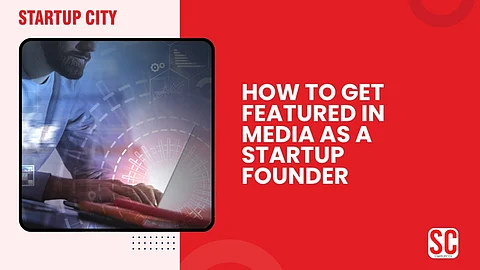

Get Featured in Media
Imagine this: You open your inbox and see an interview request from a leading business magazine. They want you—yes, you—to share your startup journey with their readers.
Feels exciting, right?
Getting featured in the media isn’t just a vanity milestone—it’s a powerful growth strategy. It builds authority, attracts customers, earns investor trust, and boosts team morale. But here’s the catch: The media doesn’t chase startups unless you give them a solid reason.
In my experience working with founders, building media visibility is part strategy, part storytelling, and a whole lot of consistency.
Let me show you exactly how to get featured in the media as a startup founder—and why now is the best time to do it.
Before we dive into the how, let’s understand the why:
Trust: A third-party media endorsement builds credibility. When Forbes, YourStory, or StartupCityIndia features you, it tells the world you're the real deal.
Visibility: Media exposure gives your brand wings. One good article can lead to a ripple effect—new clients, partnerships, and press.
Investor Appeal: Investors research founders. A Google search that leads to your media interviews gives you a sharp edge.
Talent Magnet: Talented professionals want to work with visible, mission-driven leaders.
Let’s break it down. Getting press is not about shouting into the void—it's about showing up with a story worth telling.
Your journey is your most powerful asset.
Journalists are not just looking for business wins. They’re looking for human stories:
Why did you start?
What challenges did you overcome?
How did you fund your startup?
What lessons can others learn from you?
Pro Tip: Structure your story like this:
The Spark: What made you start?
The Struggle: What hurdles did you face?
The Shift: What changed your trajectory?
The Success: What impact are you making?
“People do not buy goods and services. They buy stories, relations, and magic.”
— Seth Godin
Before media contacts you or considers your pitch, they’ll research you.
Make sure these basics are covered:
LinkedIn: Updated bio, achievements, startup journey.
Website: Professional, with an active blog or press section.
Twitter/X and Instagram: Thoughtful content around your niche.
Founder Bio Kit: A Google Drive folder with your high-res headshot, bio, and key links.
You don't need millions of followers—you need authenticity and consistency.
Thousands of startups are launching every month. So why should the media care about yours?
You need an angle.
Examples of media-worthy angles:
"How this 26-year-old founder built a bootstrapped SaaS from a college dorm"
"Meet the woman solving rural water crisis with AI-powered tech"
"Ex-Infosys employee turns farmer to launch organic startup impacting 20K lives"
Ask yourself:
“What makes my story fresh, inspiring, or relevant right now?”
You don’t always need a PR agency to get started.
Use these tools and communities:
StartupCityIndia, YourStory, Inc42 – open to founder pitches.
HARO (Help A Reporter Out) – journalists post real-time quote requests.
Qwoted, Press Hunt, Prowly – platforms to connect with reporters.
LinkedIn – follow and engage with journalists covering your space.
Build relationships before you pitch. Comment on their posts. Share their stories. Create warm leads.
Here’s the truth: Journalists don’t owe you coverage—they choose stories that fit their readers.
Your pitch should be short, sharp, and relevant.
Here’s a winning pitch formula:
Subject: Story Idea – How a Tier-2 Startup Is Solving XYZ Problem in India
Hi [Journalist's Name],
I’m [Your Name], founder of [Startup Name], and I’ve been following your work on [Topic].
Our team recently [achieved something unique], and I thought it could be relevant for your readers.
Here’s a quick snapshot: - Built a platform impacting [X people/clients] - Solved a [pressing problem] using [innovative method] - Bootstrapped/got funded by [XYZ] within [timeline] Happy to share more details or connect if this sounds like a fit.
Thanks,
[Your Full Signature with Links]
Keep it under 200 words.
Make it about the story, not just self-promotion.
Follow up after 5–7 days if no reply.
The media thrives on content that informs, inspires, or educates.
You can:
Publish thought-leadership posts on LinkedIn.
Share mini-case studies or client success stories.
Record behind-the-scenes founder videos on Instagram Reels or YouTube.
If you build engaging content, journalists will find you.
When others recognize your work, media pays attention.
Ways to build proof:
Apply for awards: TiE, NASSCOM, Forbes 30U30, Startup India, etc.
Appear on startup podcasts (like The Musafir Series, The Indian Dream).
Speak at webinars, college events, or startup meetups.
Visibility builds credibility. Each feature leads to more.
Rohit, a 27-year-old founder from Jaipur, launched a D2C skincare startup during the lockdown. With no PR budget, he:
Shared his story in a LinkedIn post (which got 12K views).
Commented on a journalist’s tweet covering D2C trends.
Sent a short email pitch with a relatable hook.
Result? A feature on The CEO Magazine followed by a Startup India showcase. Today, his brand appears in Google News results—and investors noticed.
That’s the power of showing up intentionally.
Mass emailing the same pitch
Focusing only on funding announcements
Ignoring journalists’ content and niche
Expecting instant replies
No follow-up or relationship building
Be human. Be helpful. Be relevant.
You’re not alone if you’ve felt invisible despite building something incredible. But visibility is not just luck—it’s strategy.
Media coverage isn't reserved for unicorns or Ivy League grads. It’s for founders who dare to show up with clarity, consistency, and courage.
So go ahead—pitch your story, polish your presence, and position yourself as a voice worth listening to.
The world needs to hear what you're building.
And we at StartupCityIndia are cheering for you.